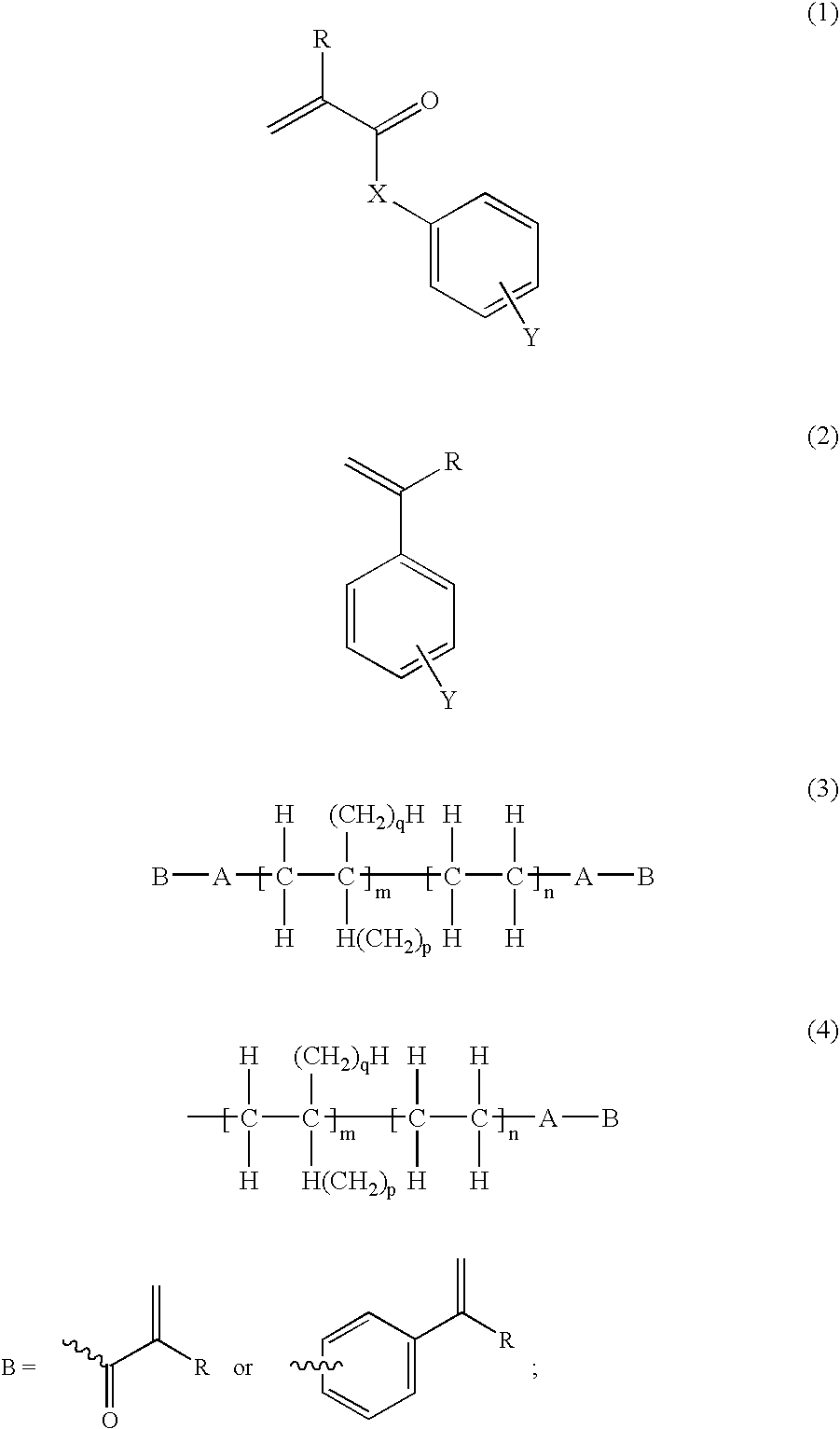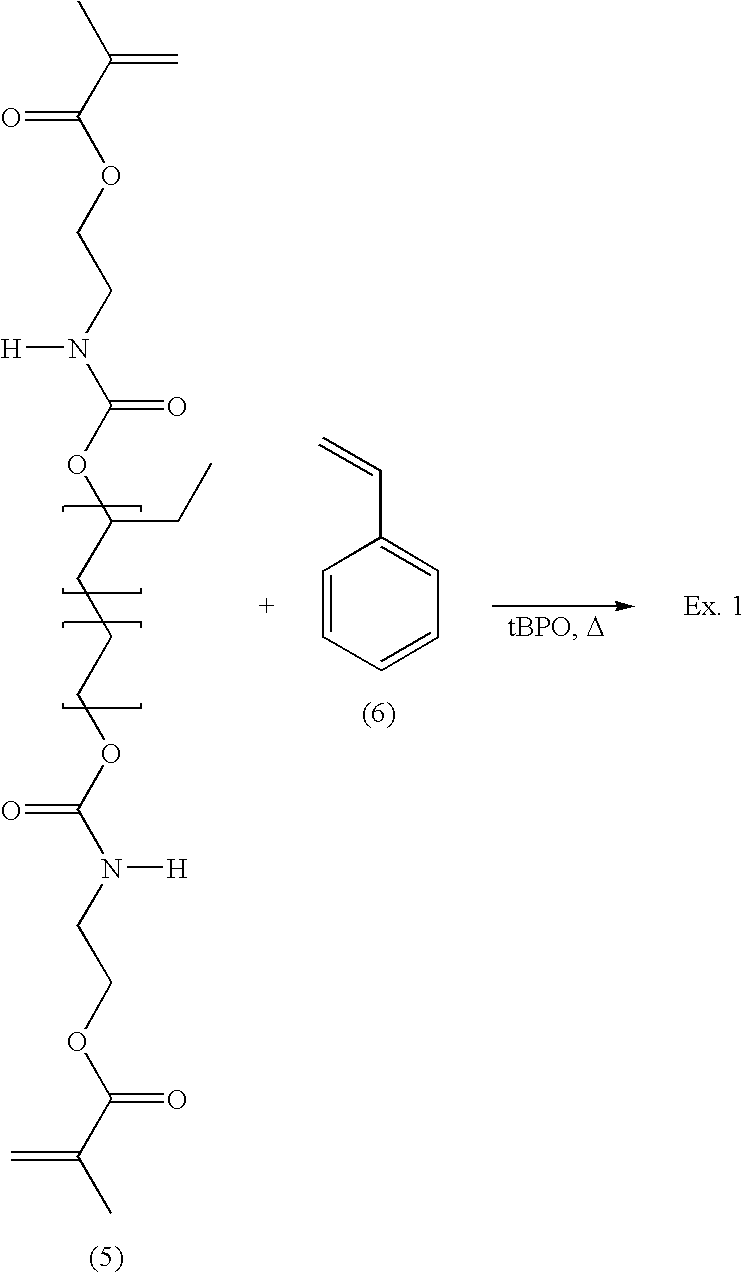Ophthalmic and otorhinolaryngological device materials
a technology of ophthalmology and otorhinolaryngology, which is applied in the field of improved ophthalmology and otorhinolaryngological device materials, can solve the problems of less desirable than other materials, explosive unfolding of hydrogel materials, and relatively low refractive index
- Summary
- Abstract
- Description
- Claims
- Application Information
AI Technical Summary
Benefits of technology
Problems solved by technology
Method used
Image
Examples
example 1
A glass vial was charged with 1.6731 g of difunctional macromer [5] having a number average molecular weight (Mn) of about 3400 and an ethylene / butylene molar ratio of about 2.2:1, 0.4519 g of styrene [6], and 0.0386 g of t-butyl peroxy-2-ethyl hexanoate (t-BPO). The monomer mixture was blended thoroughly and poured into a polypropylene mold. The open mold assembly was placed under vacuum to remove entrapped air from the monomer mixture. The filled mold was returned to ambient pressure then closed and cured at 110° C. for 18.5 hr. The resulting material exhibited excellent clarity and flexibility, and cured with minimal shrinkage. The cured polymer was extracted in refluxing acetone for 3 hrs. The acetone was decanted and the product was rinsed with fresh acetone then dried under vacuum at 60° C. for 3 hrs. Representative tensile and thermal properties are listed in Tables 1 and 3.
example 2
A glass vial was charged with 1.7056 g of the same difunctional macromer [5] used in Example 1, 0.6813 g of benzyl methacrylate (BzMA), and 0.0424 g of t-butyl peroxy-2-ethyl hexanoate (t-BPO). The monomer mixture was blended thoroughly and poured into a polypropylene mold. The open mold assembly was then placed under vacuum to remove entrapped air from the monomer mixture. The filled mold was returned to ambient pressure, then closed and cured for 1 hr at 70° C. then 2 hrs at 110° C. The resulting material exhibited excellent clarity and acceptable flexibility, and cured with minimal shrinkage. The cured polymer was extracted in refluxing acetone for 3 hrs. The acetone was decanted and the product was rinsed with fresh acetone then dried under vacuum at 60° C. for 3 hrs. Representative tensile properties are listed in Table 1.
example 3
A glass vial was charged with 1.6916 g of the same difunctional macromer [5] used in Example 1, 0.6812 g of 2-phenylethyl methacrylate (2-PEMA), and 0.0445 g of t-butyl peroxy-2-ethyl hexanoate (t-BPO). The monomer mixture was blended thoroughly and poured into a polypropylene mold. The open mold assembly was then placed under vacuum to remove entrapped air from the monomer mixture. The filled mold was returned to ambient pressure, then closed and cured for 1 hr at 70° C. then 2 hrs at 110° C. The resulting material exhibited excellent clarity and flexibility, and cured with minimal shrinkage. The cured polymer was extracted in refluxing acetone for 3 hrs. The acetone was decanted and the product was rinsed with fresh acetone then dried under vacuum at 60° C. for 3 hrs. Representative tensile properties are listed in Table 1.
PUM
| Property | Measurement | Unit |
|---|---|---|
| wt. % | aaaaa | aaaaa |
| wt. % | aaaaa | aaaaa |
| wt. % | aaaaa | aaaaa |
Abstract
Description
Claims
Application Information
 Login to View More
Login to View More - R&D
- Intellectual Property
- Life Sciences
- Materials
- Tech Scout
- Unparalleled Data Quality
- Higher Quality Content
- 60% Fewer Hallucinations
Browse by: Latest US Patents, China's latest patents, Technical Efficacy Thesaurus, Application Domain, Technology Topic, Popular Technical Reports.
© 2025 PatSnap. All rights reserved.Legal|Privacy policy|Modern Slavery Act Transparency Statement|Sitemap|About US| Contact US: help@patsnap.com



